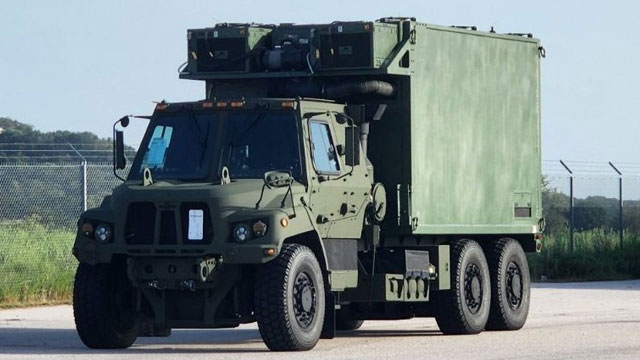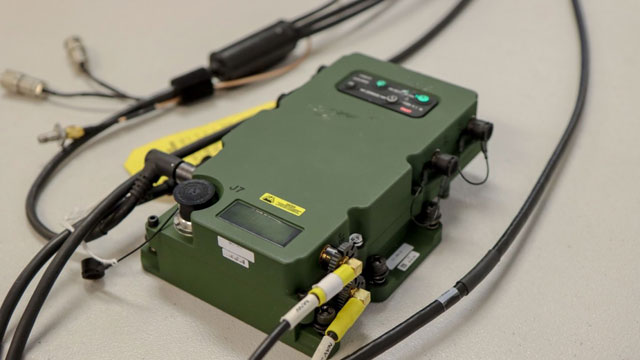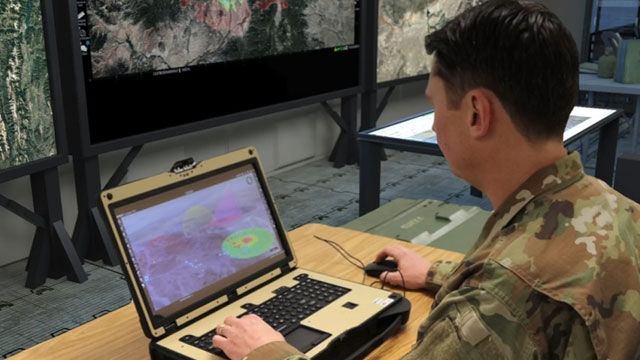By Shawn Nesaw | PEO IEW&S Strategic Communications

Tactical Intelligence Targeting Access Node (TITAN) is a scalable and expeditionary intelligence ground station. TITAN leverages Space and High Altitude, Aerial, and Terrestrial layer sensors to nominate targets directly to fires command and control networks as well as multi-discipline intelligence support to targeting and SA/SU in support of mission command. (PEO IEW&S Strategic Communications)

Mounted A-PNT System (MAPS) provides trusted and Assured PNT to Soldiers on Army platforms in contested environments by distributing PNT to onboard systems that support navigation, mission command, fires and maneuver. MAPS provides access to modernized military GPS and fuses additional sources of PNT to include timing and alternate navigation technologies. (Photo Credit: PEO IEW&S Strategic Communications)

Electronic Warfare Planning and Management Tool (EWPMT) is the Commander’s tool to visualize, control, manage, and dominate the electromagnetic spectrum. At end state, EWPMT will provide the ability to plan, model, and manage EW assets (Multi-Function Electronic Warfare – Air Large and Terrestrial Layer System) to execute operations. (Photo Credit: PEO IEW&S Strategic Communications )
As the U.S. Army continues to pace the threats around the world, Long Range Precision Fires (LRPF) play a critical role in Multi-Domain Operations. To enable the Army to strike targets from increased distances with speed and accuracy requires advanced technology.
Program Executive Office Intelligence, Electronic Warfare & Sensors (PEO IEW&S) programs support every stage of the fires targeting cycle through enabling capabilities specific to Positioning, Navigation, and Timing (PNT), Intelligence and Analytics and the Electromagnetic Spectrum.
“PEO IEW&S capabilities are critical to Long-Range Precision Fires (LRPF) modernization, particularly within the D3A (Decide, Detect, Deliver, Assess) Targeting Cycle. These intelligence-gathering and fusion tools significantly enhance the ‘Detect’ phase, enabling commanders to locate high-payoff targets in near real-time,” Brig. Gen. Rory Crooks Director, Long Range Precision Fires Cross Functional Team explained. “This ability allows for dynamic and accurate engagement of targets at greatly extended ranges due to LRPF modernization efforts and data integration from multiple sensors. Additionally, PEO IEW&S developments bolster the ‘Assess’ phase, providing commanders greater confidence in target effectiveness and enabling the fires enterprise to swiftly prioritize and engage the next target.”
PNT | Fires
PNT is a foundational element key for long-range precision fires, supporting every stage of the targeting cycle. Project Manager PNT delivers the cutting edge PNT capabilities the Army needs to ensure the Army can strike targets fast and accurately to disrupt enemy operations.
“We keep all the networks talking and communicating,” Mike Trzeciak, PM PNT explained. “We enable that gun to know its position, have timing synchronization and provide the satellite data required to the munition for it to fly its trajectory.”
PNT ensures synchronization and communication across networks, including command and control systems, fire control systems, and munitions. PNT provides accurate timing and position data to the Army through its Mounted Assured PNT System (MAPS) and Dismounted Assured PNT System (DAPS).
“We’re on a mission at PM PNT to provide Soldiers with the best Assured PNT we can so they always have PNT in GPS-degraded and denied environments,” Trzeciak said.
Fielding of MAPS to armored platforms has been taking place over the last two years and continues to integrate with the Maneuver-Short Range Air Defense, Indirect Fire Protection Capability and additional vehicles and emerging platforms.
PM PNT’s impact extends to supporting Joint All-Domain Command and Control and aiding advancements like M-code, a highly secure GPS signal with improved resistance to jamming and interference, to support modern military operations.
Intelligence | Fires
Intelligence is a critical enabler for long-range precision fires and the broader fires community, as effective targeting cannot occur without accurate and timely intelligence.
Programs like the Army Intelligence Data Platform (AIDP) and the upcoming Tactical Intelligence Targeting Access Node (TITAN) system play vital roles in the fires targeting cycle.
“You can’t do targeting without intelligence,” Col. Chris Anderson, (former) PM Intelligence & System Analytics and former artillery officer said. “TITAN will leverage national intelligence assets to identify and recommend targets, supporting dynamic targeting and rapid communication with fires cells.”
For more deliberate, long-term, and strategic planning, AIDP enables Soldiers to analyze and prepare for engagements at a higher operational level. Together, these systems ensure that intelligence supports both immediate and strategic targeting needs, enhancing the overall effectiveness of precision fires.
Looking ahead, the integration of these capabilities with the Joint Fires Network and other Department of Defense-level tools will further advance the Army’s ability to conduct deep sensing and strategic-level targeting. This will allow the Army to prioritize dynamic, mobile targets while leveraging joint resources for deliberate, large-scale planning.
Collaboration with entities like the Fire Support Command and Control at PEO Command, Control, Communications, and Network, which focuses on systems like the Artillery Execution Suite (AFATDS) and the next-generation joint targeting system, will be crucial in shaping the future of targeting and fire support. These advancements will help the Army maintain a leading edge in precision fires while ensuring seamless coordination with joint and allied forces.
EMS | Fires
The systems PM Electronic Warfare and Cyber (EW&C) develops play a vital role in supporting long-range precision fires by leveraging advanced sensors to detect and identify targets within the electromagnetic spectrum (EMS). Long range sensing is typically radars and over-the-horizon communication signals that produce a large EMS signature.
“If we can identify those enemy assets in the EMS, we can provide that information across the network to Fire teams who can target and defeat them, leaving the enemy at a disadvantage,” Ken Strayer, Project Manager EW&C stated.
Key programs like Multi-Function Electronic Warfare Air-Large (MFEW-AL) and the Terrestrial Layer System-Echelon Above Brigade (TLS-EAB) will extend sensing capabilities to support Multi-Domain Operations. By integrating these sensors into the Army’s broader targeting architecture, EW&C systems enable precise detection and tip-and-cue functionality, ensuring accurate verification and targeting for long-range strikes.
In modern warfare, fires isn’t just kinetic. The Army leverages non-kinetic fires including electromagnetic, cyber, and other technological means to disrupt, degrade, deny, or manipulate enemy capabilities. These effects are critical components of Multi-Domain Operations, allowing the Army to maintain operational superiority.
Electronic Warfare Planning and Management Tool (EWPMT) is the nexus for non-lethal fires. PM EW&C is directly tied in with the Fires community to ensure its systems, such as EWPMT, are integrated from both a data and an architecture perspective.
“We’re focused on data centricity and on manipulating the same shared data and making sure the right data is in the right place at the right time,” Strayer said. “It has to reflect the real situation on the ground.” EWPMT is designed with data centricity in mind.
“EWPMT is in the midst of an architecture update to the Tactical Assault Kit framework to align it with the data centric approach,” Strayer added. That’s needed to support targeting for both lethal and non-lethal fires. By prioritizing shared data and common architectures, the PM EW&C supports cohesive and adaptive targeting strategies that maximize effectiveness across the spectrum of operations.
Supporting the Army
PEO IEW&S is a key enabler for Multi-Domain Operations as the organization sits at the crossroads of multiple Army modernization efforts including Long Range Precision Fires.
Due to the PEO’s extremely diversified portfolio, it supports a wide-range of organizations throughout the Army, as well as Joint partners. The organization works closely with a wide range of industry and government partners to deliver the most advanced capabilities to outpace the threat with technical excellence, adaptability and rapid solutions that support a broad range of operating environments.

